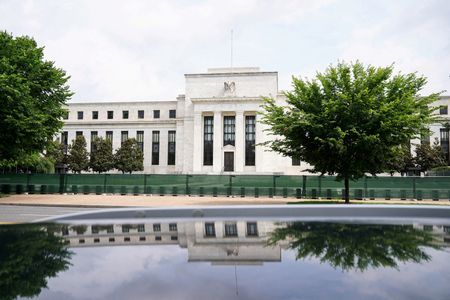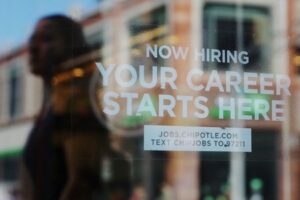By Lindsay Dunsmuir
(Reuters) -U.S. economic activity expanded more slowly from the middle of July through late August and businesses pulled back on hiring, signals that underscore why the Federal Reserve is set to begin to lower interest rates later this month.
The U.S. central bank’s latest temperature check on the health of the economy also showed that inflation pressures increased at a modest pace, with input costs viewed by all but one of the Fed’s 12 districts as generally easing.
“Economic activity grew slightly in three districts, while the number of districts that reported flat or declining activity rose from five in the prior period to nine in the current period,” the Fed said on Wednesday in the survey known as the “Beige Book,” which polled the business contacts of each regional Fed bank through Aug. 26. “Employers were more selective with their hires and less likely to expand their workforces, citing concerns about demand and an uncertain economic outlook.”
Fed Chair Jerome Powell and his colleagues have made it clear they intend to cut the central bank’s benchmark interest rate from the current 5.25%-5.50% range, where it has been for more than a year, at their Sept. 17-18 policy meeting. The only uncertainty revolves around whether weakening labor market conditions merit a quarter-percentage-point cut or a larger-than-normal half-percentage-point reduction.
Consumer spending edged down in most of the Fed’s districts, according to the report, which is released roughly every six weeks, having generally held steady during the prior reporting period.
For example, the Richmond Fed said consumer spending in its district had “softened slightly” in recent weeks. That included a hardware retailer saying average sales were down, a restaurant chain looking to boost sales through menu promotions and vehicle sales slipping as high interest rates made financing more expensive.
The Fed is trying to engineer a so-called “soft landing” for the economy in which economic growth gradually slows and the unemployment rate remains relatively low even as inflation, which spiked to a 40-year high two years ago, returns to the central bank’s 2% target rate.
After being stung by higher-than-expected inflation in the first part of this year, the pace of annual price increases came down, by the Fed’s preferred measure, to 2.5% in July and officials are increasingly confident they will reach their goal.
REDUCED SHIFTS, HOURS
Instead, attention has turned to a jump in the unemployment rate to nearly a three-year high of 4.3% in July, the fourth straight monthly rise in the jobless rate, amid increasing concerns that high borrowing costs may be dampening labor demand too much.
So far, the slowdown in the job market has been mostly driven by a decline in hiring rather than layoffs, a feature backed up by the Fed’s survey, which described reports of layoffs as remaining low. Job openings dropped to a 3-1/2-year low in July, data earlier on Wednesday showed.
Five Fed districts reported slight or modest rises in employment growth, but a few districts said firms “reduced shifts and hours, left advertised positions unfilled, or reduced headcounts through attrition.”
The Atlanta Fed said several contacts noted they were slowing the pace of hiring, and a few other districts said they were reducing workers’ hours.
There was further good news on inflation, with firms generally expecting price and cost pressures to stabilize or ease further. Several districts reported consumers were becoming more choosy about purchases, in line with recent trends.
“One large online retailer noted that many visitors mostly sought products with markdowns and those with promotional prices,” the San Francisco Fed said, while the Boston Fed reported a clothing retailer planned price cuts on popular items “in a bid to win back customers deterred by a series of price increases since the pandemic.”
Investors currently expect the Fed to lower borrowing costs this month as well as in November and December.
(Reporting by Lindsay Dunsmuir; Additional reporting by Ann Saphir and Dan Burns; Editing by Andrea Ricci and Paul Simao)





